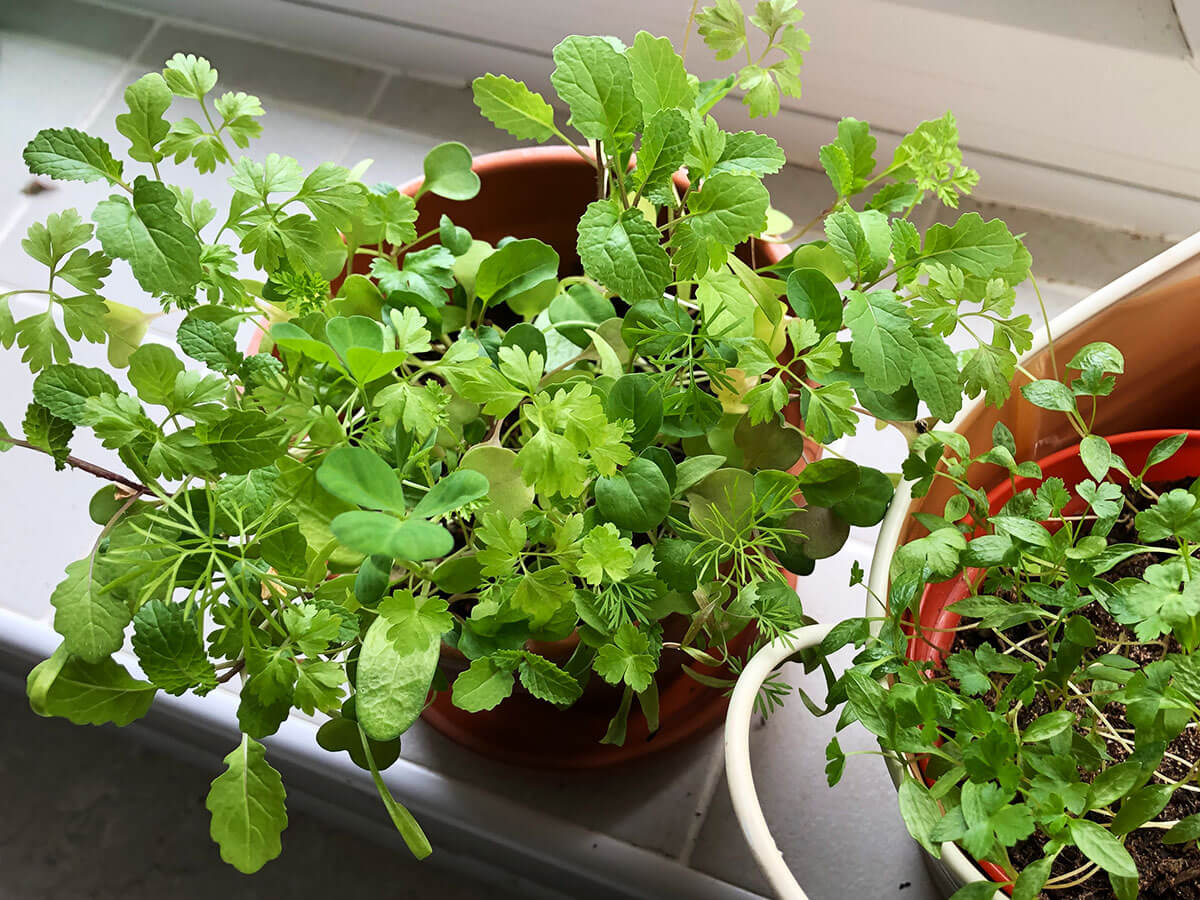11 Vegetables You Can Grow Indoors on a Windowsill
April, 2023 |Gardens aren’t just for the outdoors! It’s possible to grow a tasty, colorful, and nutritious variety of crops indoors on a windowsill. Herbs are always a popular choice for windowsills, but there are lots of other tasty vegetable plants you can grow to create your own mini vegetable windowsill garden!
So if you don’t currently have access to a garden, balcony, or windowbox (or you simply want to expand your small garden harvests!) it’s still possible to grow nutritious greens and veg indoors.
Growing food indoors
When growing vegetables indoors, there are several factors you need to consider to give your plants the best conditions to really thrive.
Light
All of these plants will need good access to sunlight throughout the day. A south-facing window is best, but more shade tolerant vegetables like lettuce and radishes will grow well on east and west-facing windowsills in summer. However other vegetables on the list need at least 6-8 hours of full sunshine a day to really thrive.
Airflow and temperature
Indoor crops need temperatures between 60-80 Fahrenheit to grow strong and healthy. Airflow is another critical element to consider when positioning your vegetables — plants need oxygen too!
- Don’t pack plants too close together to allow good airflow in between, this can minimize the chance of plant diseases.
- At the height of summer, in full sunshine temperatures can soar on south-facing windowsills. For some of the tender vegetables on this list, like lettuce, could make them wilt. Placing them in a partially shady area near an open window is best.
- Don’t place vegetable plants near hot surfaces (like on top of a fridge) or near stovetops. The residual heat could damage them.
- Likewise, don’t place vegetable plants next to aircon vents or fans where they could become too cold.
Soil
Just like container gardening outside, indoor plant roots won’t have access to underground water or soil nutrition. This means you need to plant your indoor vegetables in good compost to help them thrive. Most compost will use up all of its nutrition and ‘goodness’ after 5-6 months, some even sooner. This means regular fertilizing is a must.
Self-pollinating plant varieties
Some fruiting plants on this list produce flowers before their fruits. Usually, flowers need pollinating before they can develop, but I’ve included self-fertile plants that will set fruits without the need for bees or cross-pollination.
If you’re planning on growing crops indoors in winter, you’ll definitely need to pay attention to these growing conditions on your windowsills.
Best vegetables to grow indoors on a windowsill
We’ve listed 11 crops that are all small in size and perfectly suited to growing in tight spaces. From windowsills to a table positioned next to a sunny glass door.
There’s an amazing variety of vegetables you can indoors, definitely enough to create a varied harvest!
1. Microgreens and cress
There are so many reasons why you should be growing microgreens on your windowsill! For starters, microgreens are one of the fastest growing crops, with usually only one to two weeks to wait from sowing seeds to having them on your plate! They can also often be bought as a little kit, with a container, growing medium, and seed packet included.
These tiny seedlings are packed with concentrated nutrition (phytochemicals). They’re usually added raw into salads or used as a decorative (but tasty) garnish on endless meals. Eating them fresh helps to preserve the nutrients making them even more nutritious.
Having them indoors, on a windowsill makes it really easy to cut off a small bunch to add to your lunch or dinner.
You can find lots of different microgreen varieties and types, from arugula to kale. Some popular microgreens include:
- Pea shoots
- Cress
- Broccoli greens
- Kale Nero di Toscana
- Chard
- Sorrel
- Mustard
- Red Amaranth

2. Radishes
Lots of quick growing crops, like radishes, are perfectly suited to growing indoors on a windowsill. These bright pink, peppery globes are perfect for windowsill growing. Like microgreens, they’ll be ready quickly, and are usually ready to eat 4 weeks after sowing!
Their small size and speedy growing time make them ideal for a narrow container along a windowsill. A 6-inch container depth should give their roots enough space to grow, without blocking too much light from your windows!
3. Herbs!
One of the most popular crops you can grow indoors on a windowsill. Herbs are a kitchen windowsill classic! Most herbs are quick-growing annuals that you can easily grow on any sunny windowsill. They’re usually very fuss-free and easy to grow.
Having them inside means easy access whenever you need to snip off some basil for a pasta dish or add a sprinkle of dill and parsley as a garnish. Or when you want to make a soothing mint tea! Plus their bright green color and soft texture bring a touch of nature into your home.
Some herbs that I always have growing on my kitchen windowsill…
- Mint (I love mint tea!)
- Parsley
- Basil
Other tasty and versatile herbs that you can use in endless recipes…
- Chives
- Cilantro (coriander)
- Rosemary
- Chervil
- Dill
- Thyme
- Majoram
- Oregano
- Sage
Some herbs will prefer bright sunshine (like thyme), while others need some shade (mint). Make sure you check their growing requirements and try to place them on the windowsill with the best possible conditions.

4. Micro Tomato Plants
With indoor micro tomato plants, you can harvest tomatoes while standing in your kitchen! There are lots of mini cherry tomato plants that are all small enough for sunny windowsills.
Some mini tomato plant varieties include:
- Micro-Tom
- Red Robin
- Sweet N Neat
In Spring, in some garden nurseries, you can find standard windowsill or patio tomato plants from brands, which often have tomatoes already starting to ripen. A quick fix if you missed the seed sowing window in early Spring!
If you’re buying seeds keep an eye on the estimated size of the plant. Micro tomatoes should be around one foot tall, whereas dwarf tomatoes could be up to four feet. Dwarf tomatoes are generally better suited to small outdoor spaces.
As I mentioned right at the top, you’ll need to double-check that your fruiting indoor plants are self-fertile. Dwarf tomatoes marketed as plants you can grow indoors on a windowsill should be self-fertile. This means they’ll set fruit without pollination, and you don’t need to invite bees into your home to pollinate the small yellow flowers!

5. Spinach
A highly nutritious leafy green that grows well indoors on a bright windowsill. As a shade tolerant vegetable, spinach doesn’t do well in bright, direct sunlight all day. This makes it ideal for windowsills that receive sunlight for only part of the day.
It’s often best to harvest the baby leaves as this keeps the spinach plant smaller, and generally keeps the plant producing leaves for longer.
6. Tom Thumb Dwarf Peas
There are some lovely dwarf peas varieties you can grow in small spaces outdoors — like balconies or small porches. But for windowsills, the Tom Thumb pea is definitely the one to choose!
It’s a fast-growing, highly compact pea plant that shouldn’t reach more than 8 inches tall! Best of all, it’ll produce a good crop of full-sized pea pods. You can buy seeds to grow your own or often find a whole plant in large nurseries.

7. Lettuce
If you struggle with garden pests eating your lettuce leaves, try growing some indoors! Plant seeds in a long container and enjoy freshly picked, pest-free lettuce in no time at all.
Loose leaf lettuce will develop more quickly and is easier to harvest baby leaves from. It is possible to grow hearting lettuce, but you can usually get multiple harvests from loose-leaf varieties.
Some of the best lettuce varieties to grow indoors:
- Tom Thumb (One of the smallest lettuce varieties)
- Warpath (One of the smallest iceberg lettuce varieties)
- Little Caesar (A compact romaine lettuce)
- Black Seeded Simpson (Loose leaf variety from the 1850s!)

8. Peppers
There are some lovely, compact pepper plants that are perfectly suited to windowsill growing. Both fiery and sweet!
You’ll definitely need a sunny, south-facing window for peppers to really thrive on a windowsill. To produce fruits they need at least 6-8 hours of sun a day.
Before you get carried away with buying pepper plants, make sure you also choose one that matches your heat tolerance!
Some compact pepper varieties include:
- Cayennetta: Compact hot pepper plant
- Peppers From Heaven: A tiny, basket pepper that produces sweet peppers
- Pot-a-peño: A compact, cascading hot jalapeño pepper

9. Mizuna
Like lettuce, these leafy greens can grow year-round in pots or trays on a windowsill. Their mild, peppery flavor is always a welcome addition to salads and also hot dishes too.
You can get multiple harvests of young leaves from one plant too. As you cut and harvest leaves, it’ll encourage the plant to produce more. Generally, you can keep harvesting leaves for a few months. So for a continual supply, sow seed every few months!
Mizuna is one of the best crops to grow indoors in winter too!
Top tips for growing Mizuna indoors:
- We recommend growing mizuna in a container that’s at least 4-6 inches deep.
- Young leaves can wilt in harsh midday sun so keeping them on a windowsill that receives a bit of shade is ideal.
10. Garlic greens
While garlic bulbs may be a bit too demanding of space on a windowsill, and also take a long time to mature, garlic greens are a great alternative! Plant garlic cloves in pots or deep trays of compost and they’ll soon take root and produce green shoots.
You can pick or trim these shoots and add them to stir fry or other dishes to add tasty flavor.
Top tips for growing garlic greens indoors:
- You can technically use garlic cloves from store-bought garlic, but I would generally recommend buying your own garlic bulbs from a nursery. You’ll know exactly what variety you have and will be able to create the best conditions for them.
11. Ginger
This flavorful, spicy little root will happily grow on a sunny window — even year-round! If you use it frequently when cooking, having your own supply is definitely a bonus.
It’s native to tropical climates in southeast Asia, so you’ll need to try and recreate those conditions as best as you can. Keep them in a sunny location, and add some gravel or stones at the bottom of their container underneath the soil to help drainage. Make sure you have a tray underneath to catch any excess water.
Make sure to choose a wide container that’s at least 7 inches deep. Ginger rhizomes need plenty of space to expand into.
Like garlic, I would generally avoid propagating store-bought ginger. Not all nurseries will stock ginger roots, but you can usually find great online suppliers. And if you can, I also always recommend choosing organic!
Tips for growing crops indoors on a windowsill
To give your happy little windowsill plants the best start and maximize your harvests, check out our top tips below…
Buying plants
Most online seed shops and local nurseries will have these crops in stock, so they should be easy to find! Microgreens will only come in seed packets, however, lettuce, pepper plants, and tomatoes, etc can usually be bought as small plants. Garlic will usually come as a bulb that you can that remove the cloves from.
Sowing from seed
If you’re sowing seeds, invest in a good bag of compost suitable for vegetables and edible plants (not house plant compost). Using garden soil or old pre-used compost may not give your plants enough nutrition.
Positioning
- Make sure you double-check the label or seed packet for the growing requirements of whichever vegetable or herb you’re adding to your windowsill.
- Some will need plenty of sunshine. So if you don’t have a south-facing windowsill, you may need to occasionally move your container to a table or surface that catches the sun later in the day. This gives the seedlings and the plant the best possible start and helps you harvest more!
- Don’t feel like you have to buy brand-new, fancy pots. You can use pretty much any container, from plastic water bottles cut in half to old plastic lunchboxes (all with added drainage holes and a water catchment tray underneath though!).
Watering
- Make sure your pot, planter, or container has drainage holes. Indoor plants still need good drainage to make sure the soil doesn’t get too waterlogged. You’ll need to also make sure you have a dish or shallow container without drainage holes underneath to catch excess water. Otherwise, you might damage your windowsill or create a bit of a mess!
- Keep plants well watered but take care not to overwater. Indoor plants will not like excess water and the roots could rot.
Lots of these vegetables can be grown throughout the year too. Check out our list of crops to grow indoors in winter to see what you can harvest indoors when the frost has killed off outdoor plants!





